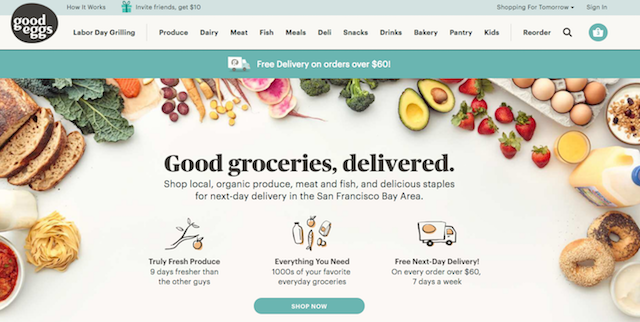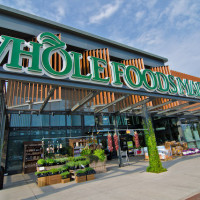
How do you turn around a failing food e-commerce business? What does it take to run and scale a profitable online grocery business specializing in fresh, local products? These are some of the tough questions Good Eggs faced last year after abruptly shuttering operations in three of its four markets. The company had built a beloved brand, but it scaled too quickly before perfecting its model and was hemorrhaging cash.
In December 2015, however, the startup brought in Bentley Hall as its new CEO, and he is quickly turning the company around. In just six months, he has taken Good Eggs from losing money on every order to profiting on every order. Taking a human-centered approach, while also focusing on profitability and logistics, he has methodically redesigned the company’s operations, improved its margins and increased existing customers’ annual spend by 50 percent. Good Eggs is on track to have the kind of turnaround story you hope for, but don’t often hear about.
With demonstrated success, Good Eggs raised $15 million last month in a new round of venture funding led by Index Ventures, with participation from S2G Ventures, Obvious Ventures, DNS Capital, Collaborative Fund, Uprising and angel investors. Both Hall and the investors declined to share the terms of the deal.
I spoke with Hall, Obvious Ventures’ Vishal Vasishth and S2G Ventures’ Chuck Templeton to understand how Hall and the Good Eggs team are turning the company around, as well as what’s next. Below are some of my key takeaways from our conversations.
1. Leadership With Domain Expertise is Really, Really Helpful
Hall is a logistics and food product person who has spent the last decade scaling mission-driven consumer brands, including Cliff Bar and Plum Organics. One of the first employees at Plum, Hall helped scale the baby food startup from $1 million to $100 million in sales in six years. As COO/CFO of Plum, he managed the startup’s finances and supply chain. During this time, he implemented margin improvement and cost engineering projects that saved the company over $42 million. He then ran innovation, launching 30-50 products per year with an 85 percent success rate. Much of this success was due to Plum’s user-centered product design approach.
When Hall looked at Good Eggs, he tells me, he saw the “bones of a great building.” The startup had a strong brand, a great team and powerful consumer-facing and warehouse management software that could not be easily replicated. “What they really needed the most help on was some operational and business things, which is exactly my core skill set,” says Hall. “From an external point of view, people thought it was really risky, and, to me, it seemed there was a clear path that we knew how to solve things [like issues with unit economics and order fill rates], which the last 6 months has proven out.”
In addition to its brand loyalty Bay Area and the size of the market, one of the main reasons S2G Ventures and Obvious Ventures invested in Good Eggs is because of Hall. “I think [Good Eggs] had grown rapidly without much discipline on the economics,” explains Vasishth. “Bentley’s leadership – we’ve know Bentley since his days at Plum Organics – has provided the right discipline the company needed, and he has shown in the last six months great progress towards to our critical metrics in the company.”
2. Human-Centered Design: Talking to Your Customers is Key
From Warby Parker to Plum Organics, some of the world’s best companies set themselves apart by embracing human-centered design techniques, which starts with identifying people’s problems and developing solutions to address them. This is certainly Hall’s approach to turning around the company. He spent his first month at Good Eggs asking customers and employees about their needs and how the company could improve its service and operations. From these conversations, he identified three low-hanging customer needs that if addressed would increase customer order size, grocery spend and frequency:
1. Offer More SKUs (Products): Customers loved Good Eggs product selection and ethos, but they wanted more. They wanted to be able to use the service for all their grocery shopping, not just for specialty items. Based on customer feedback about what products they felt were missing, Hall added over 1,000 new SKUs to the platform. He also wanted to ensure more people could afford to shop through Good Eggs, so he used a “good, better, best” approach to sourcing to offer products with a wider range of price points.
Templeton shares an example of how Hall is thinking strategically about building out its SKUs:
“Bananas were one of the number one requested items by a lot of their customers. While there are not a lot of bananas grown in the Bay Area, so they can’t offer local bananas, Good Eggs looked for a source that’s sustainable and within their mission. [Adding bananas to the store] helps drive more local sales, because now more people are shopping because they can get their bananas, which means they are now [also] buying more local goods.”
2. Better Order Fill Rates: When Hall joined Good Eggs, the company had a 75 percent order fill rate, which meant customers often didn’t receive full orders. To address this issue, Hall focused on improving inventory management and creating a tighter connection between its inventory and website to show true product availability. He also implemented a new, digitized process for picking and packing orders to reduce room for human error.
3. Convenience: From delivery times, to product offerings to customization, convenience is king in online grocery. In the past, Good Eggs customers would have to wait a couple of days to receive an order. Today, Good Eggs is making a number of incremental improvements to make its service more convenient. To start, it now has a 12 a.m. cut-off time for next day delivery. Soon it will be launching same day delivery, which will enable someone to order groceries by 1 p.m. and have them delivered by 5:30 – 7:30p.m. The service may have a longer lead time than Amazon Fresh or Instacart, for example, but it will allow Good Eggs to balance its customers’ convenience needs with its business needs.
Good Eggs is also thinking about other areas of convenience. In the future, for example, the startup may venture into prepared meals. It may also focus more on customization by dietary restrictions and preferences.
“The beauty of digital grocery stores is that they should be able to transform based on who you are,” says Hall. “Imagine you walk into our store and filter it based on what your dietary restrictions are, and the SKUs – which are already curated – that you can’t eat just get removed from the mix. Then, whether it’s prepared meals or groceries, you have options that are really clear. And as you’re adding things to your basket it’s giving recommendations for completing a recipe, and adding wine and things like that. We’re not fully there yet, but that is certainly something that online grocery can do better than the other [brick and mortar] players.”
Templeton says online grocery is a really big market, and one of the key ingredients to Good Eggs’ success will be its focus on their customers and innovating around their needs. “They can’t be all things to all people,” says Templeton. “I think they really have to understand their customer better than anyone else and make sure they are providing exactly what that customer needs in a profitable way.“

3. Focus on Profitably From Day One
When Hall joined Good Eggs, the company was losing money on every order. Today, it’s making money on every order. How did he do it? He focused on measuring contribution margin per order, which came down to increasing basket size, improving gross margin and reducing variable costs.
I’ve already gone into detail about how Good Eggs increased basket size above, so I’ll move on to gross margin. To improve gross margin, Hall focused on perfecting the company’s order rate to minimize spoilage. The company also got smarter about its SKUs from a margin assortment perspective, getting more efficient about how they buy and price products.
For variable costs, Hall identified the areas with the highest costs, like packaging, order picking and delivery. For each area he would identify the top three things that could be changed and then make the changes happen. “In every one of those areas,” explains Hall, “we’ve seen at minimum 40 percent reductions in those costs per orders.”
As the former CEO of OpenTable and Director of Grubhub, Templeton has had his fair share of experience building two-sided marketplaces. One of the main reasons S2G invested in Good Eggs, he says, is because of Hall’s intuition around profitably growing both sides of the marketplace concurrently.
Vasishth says venture capitalists have been overly focused on celebrating revenue and not enough on profitability. “I think we need to go back to how do you build good, old-fashioned businesses – which people desire and where we make their lives better – in a way that we charge fairly and have return on capital, so that you can be in business for long term,” he says.
4. Food Delivery Startups Are Food Companies Enabled by Technology
“We’re a food company that’s enabled by tech, we’re not a tech company enabled by food – and there’s a huge difference there,” says Hall.
I see so many talented, passionate entrepreneurs coming into food who see technology as a panacea for all the inefficiencies in food. Both Good Eggs and Farmigo learned the hard way that this is not always the case.
“We’ve had to shift our mindset to being a food company first,” says Hall. “[Good Eggs was] always really driven by food, don’t get me wrong, but they did put tech high on that list. Tech is incredibly important, but, again, it enables, it’s not the sole thing.”
5. Inventory Isn’t as Scary as You Think
While in the past Good Eggs had a just-in-time model, where it didn’t own its own inventory, today it does own inventory. While time will tell if he’s right, Hall believes that owning a curated, yet limited inventory set, leveraging technology to understand what products are moving and when and having a team that is wholly focused on packing and delivery is much more efficient than a brick and mortar retail chain doing home delivery. Having 3,000 highly curated SKUs versus the 15,000 – 60,000 SKUs the average grocer has makes inventory much more manageable for Good Eggs.
“Our spoilage is actually really, really low — way lower than a traditional grocery store, even though our portion of products that are sold that are fresh is way higher, and a lot of that is technology,” says Hall. “A lot of that is the fact that stuff is coming in a day or two after harvest, as opposed to 10 or 11 days [like traditional grocers]. This means that our stuff is fresher. We’re [also] turning inventory so much faster than a traditional grocer that we don’t actually have a ton of working capital tied up in inventory.”
6. Scale Once You’ve Proven Your Model
As I wrote about last year, one of Good Eggs’ biggest issues was scaling too quickly before understanding its model. Hall does not plan to make the same mistake again. He explains:
“I want to make sure that we are continuing to perfect the model here in the Bay Area, continue to get really great growth in the Bay Area. We will certainly expand to other cities in the future, but when we do so it’ll be intentional, methodical and we’ll do it will a proven, perfected model, and not try to figure it out as we go. I think the top 10 West Coast markets are somewhere between a $10 and 20 billion total market opportunity for good online grocery and that will keep us busy for a few years.
Both S2G Ventures and Obvious Ventures are investing in Good Eggs’ long-term success, along with its other investors. They understand it’s going to be a journey and want the company to scale only once it’s nailed its model in one market. When it does scale, they say, it should be in synergistic markets that have the right population density, cost capabilities and product availability.
It can be easy for startups and investors to get blinded by large valuations and big markets, but investment dollars and valuation do not equal success. In food e-commerce, the winners will be the companies who can profitably meet their customer’s evolving needs while growing sustainably.





